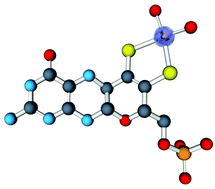Molybdenum: biological activity and metabolism†
Abstract
Molybdenum and tungsten are available to all organisms, with molybdenum having the far greater abundance and availability. Molybdenum occurs in a wide range of metalloenzymes in bacteria, fungi, algae, plants and animals, while tungsten was found to be essential only for a limited range of bacteria. In order to gain biological activity, molybdenum has to be complexed by a


 Please wait while we load your content...
Please wait while we load your content...